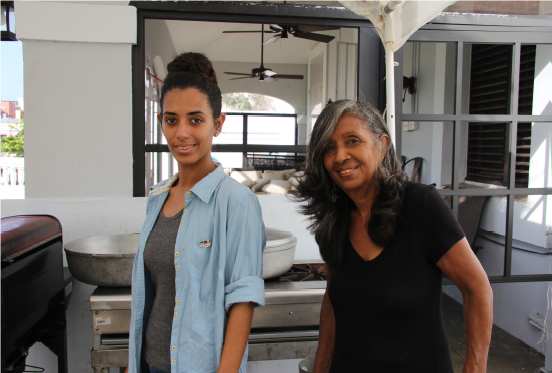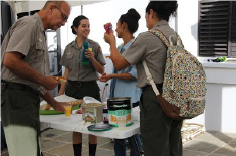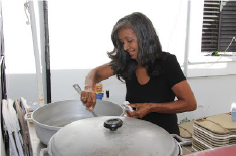Last updated: May 24, 2021
Article
Rebuilding A Sense Of Community After A Disaster: Post-Hurricane Response to the National Parks in the Caribbean

NPS photo
Watching her coworkers working long days, up to 16-hour shifts, starting early in the morning and returning back to employee housing tired and eating what was convenient, Indra Brugueras, a seasonal worker at San Juan National Historic Site knew exactly what she could do to help. Together with her abuela (grandmother), Isabel Pizarro, they set out to rebuild a community one bite at a time.

NPS photo
Hurricane Irma had passed through the six units of the National Parks of the Caribbean. The city of Old San Juan where Brugueras lives received winds up to 185 mph and lost power and water as a result. National Park Service employees working and living at other parks in the Caribbean were displaced when their facilities and housing were also destroyed. Many were temporarily relocated to San Juan National Historic Site on Puerto Rico while recovery efforts were being made.
Brugueras had just finished her last day of work for the season at San Juan National Historic Park the day before Hurricane Maria hit Puerto Rico. As she watched her coworkers working tirelessly, she knew she needed to help somehow, but unable to help unload supplies due to an injury, she knew her hands could make a difference. “I saw coworkers come in to work, many who lost everything. Some of them looked so sad. They didn’t have a way to eat a hot breakfast, not even a hot cup of coffee, sometimes they had nothing to eat for lunch. So I enlisted the assistance of my abuela. She and I are always connected, always willing to help each other,” said Brugueras.

NPS photo
Brugueras knows how to cook, and how to do so on a shoestring budget. She learned frugality from being a college student and from completing several internships but she can attribute a lot of the cooking skills to her abuela, as her grandmother used to be a caterer. Together they set out to raise the spirits of not only of her coworkers, but those of an entire community.
They started cooking in Brugueras’ apartment, using the groceries she had on hand, bringing a hot breakfast and lunch to her coworkers, all for a just a free-will donation. “We had employees, kids, mothers, and others show up to eat a hot meal with each other,” said Brugueras. Day-by-day and bite-by-bite, people began to develop a greater sense of community. Pizarro stated, “We soon began to forget that we just had a hurricane, because we were focusing on each other and coming together as a community, sharing compassion over a hot meal.” They both agreed when Pizarro said, “There is something gratifying about taking a situation where things are so bad, but at this moment we can stop, take a break from the chaos, and share a meal and a story to help each other with the grieving process.” Some of the folks they served up meals have even given nicknames to Brugueras and Pizarro; “Batman and Robin” and even “Miss Humanity and her Abuela.”
San Juan National Historic Site employee Angel Cuevas said, “The smiles and extra efforts of Indra and her abuela have provided emotional support for many employees at the park as well as some good food.” The volunteer cooks have also been dealing with their own impacts from the hurricane, such as no power or water, and, many of their possession were damaged. Cuevas said, “I admire their strength and it has helped me and other employees to continue on.” Cuevas believes it is all a circle of life, of society and of the National Park Service. He said, “They are caring for us as family, and we are caring for the structures and stories of this special place so we can share it with the visitors.”
Pizarro remembers back to her younger years. She has seen many hurricanes come through Puerto Rico. Not divulging her age, she said she has seen many, but nothing like Maria. She said, “I grew up in a time when we had a sense of community, where you knew your neighbors, you had actual conversations. That has changed over time and people have become more focused on themselves. People are spending more time conversing through technology, and are too busy to talk neighbors because they need to run off to a meeting, or take the kids to soccer practice.” So, after serving breakfast and lunch for park employees, the duo would return home to do the same for their own neighbors. Pizarro stated, “We began to break down stereotypes at our meals. We have lawyers, shop owners, and government officials coming together and sharing what food they had in their pantries to make a meal for the community. People are learning to give thanks again, to show appreciation for one another, and to learn to not be so proud to say they need assistance.”
Within their community at San Juan National Historic Site, the employees have become family to Brugueras and Pizarro, and vice versa. They are optimistic about the future and believe everyone can contribute to taking care of others, and the special treasures of the National Park Service.
